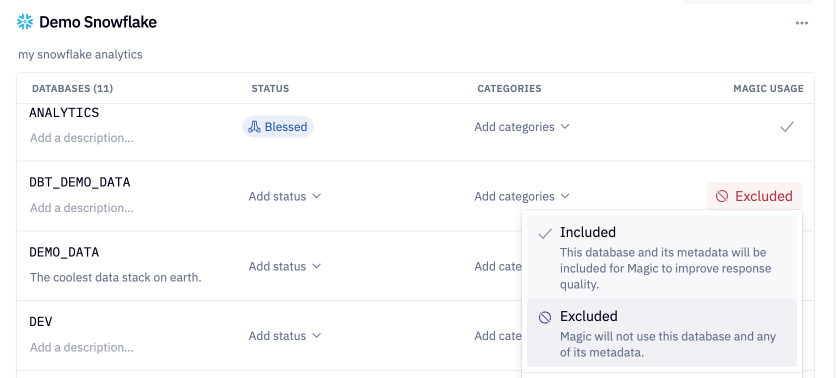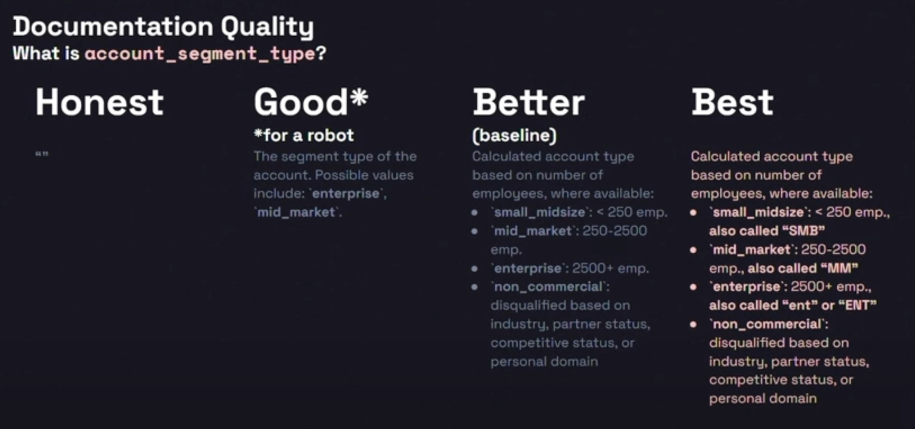Setup your workspace for AI agents
The best way to think about enabling Hex agents is similar to the way you'd think about enabling a new analyst - they have all the core fundamentals and know how to write great SQL or Python but they lack business context. The lack of context can lead to incorrect assumptions when facing an abundance of data. Great data curation is the #1 lever you can pull to return higher quality results.
This tutorial outlines steps that help provide Hex agents with a focused view on relevant information, leading to more accurate suggestions.
Hex agents are meant as a way to augment, not replace, human insight and judgement. You should not rely on AI-generated code to be accurate, complete, or free from bias.
Warehouse Curation
Setup the default data connection
Generally, the majority of users in your Hex workspace only need access to a subset of the data in your warehouse. Access to all of the tables and databases can be confusing for both humans and agents.
The default data connection in your Hex workspace should tailored to only have access to the schemas/databases that the majority of users need to use, thereby giving a focused view of the data.
You can control the data exposed in the default data connection by either:
- Creating a new role/permissioning structure in your warehouse directly. This will prevent users from querying tables outside of the schema/databases this role has access to.
- Use Hex's schema filter feature - this will only pull in schema details based on regex rules you set. This is a lightweight way to curate your data connection without any extra work in the data warehouse.
Schema filtering is not a security feature and users can still query the underlying tables directly if the user has proper permissions to do so.
Once you have your default connection set up, you can set up scheduled refreshes to ensure we’re regularly resyncing and making sure agents have access to up-to-date schema information and metadata.
Endorse data the agent should use
Adding an endorsed status to a database, schema, table, or semantic model is the easiest and fastest way to help agents (and end users!) know what data is "Approved" or "Trusted" by data leaders. Endorsed data will be prioritized for all AI features. Child data objects will inherit their parent's Endorsed status and also will be prioritized - so it's easy to endorse an entire database or schema with just one click!
Exclude data the agent shouldn't use
If you want to maintain access in the Data browser to certain databases/tables/schemas but never want agents to use these tables, you can toggle the "Include/Exclude for AI" setting. Child data objects will inherit their parent's exclusion state, so if you've excluded an entire database, all schemas, tables and columns contained within would also be excluded from AI.

Add descriptions to your data
Table and column descriptions saved in your warehouse get synced with every schema refresh. Agents can use this context to generate better results. If you use dbt, you can take advantage of our dbt Cloud integration - once set up, Hex will sync all your descriptions which agents will automatically leverage.
What to include in descriptions
- For a table:
- Information about what a table should be used for and what things can be calculated with it
- For a column:
- Add enumerated values for all low cardinality columns
- For text values, add an example in the description and describe a pattern it might follow:
- Example:
State: Text column following the pattern: CA , AZ , NV
- Example:

Above is an excerpt from our data team's Coalesce talk on documentation best practices - you can listen in here!
Test the impact of adding descriptions
If you want to prototype descriptions and see how agents use them, you can directly edit the description fields in Hex within the Data browser UI. You can then ask a Hex agent your question and observe the results, updating the descriptions as needed!

If you want a Hex agent to use a specific table, you can @mention the table in the prompt.
Semantic Models
A semantic model is “instructions for use” for a given set of tables. How should an agent calculate measures based on the columns? What are valid joins and aggregations? Semantic models encode this up front, so everyone knows how to use the data correctly downstream.
This is an immensely useful concept for “self-serve” analytics, where you want a broader set of users in the organization to leverage data in a consistent, standardized way. Adding semantic models to your workspaces creates a single-source of truth for metric definitions like Revenue and entities like Customers.
Semantic models can be either defined directly in Hex, using Hex's Semantic Authoring or synced from our integrations partners, such as dbt, Cube, and Snowflake, with Semantic Model Sync.
Once the semantic models are configured, agents will prefer to use the definitions encoded in the models, rather than querying the warehouse directly.
Workspace Rules File
The Agent Workspace Rules file allows Admins to provide additional context to Hex's agents through a markdown file. This context is used by all AI agents in Hex when generating responses, helping them better understand your business context, data conventions, and preferred practices.
This feature is similar to Claude Projects or Cursor rules - by providing consistent, high-level context to Hex agents, you can ensure consistency across threads.
Since these rules apply to the entire workspace, only workspace Admins can modify the rules.